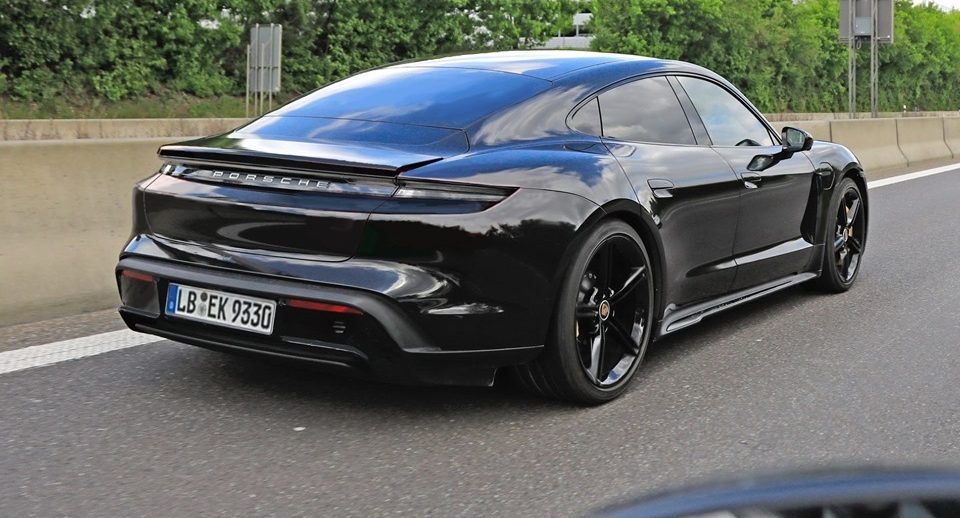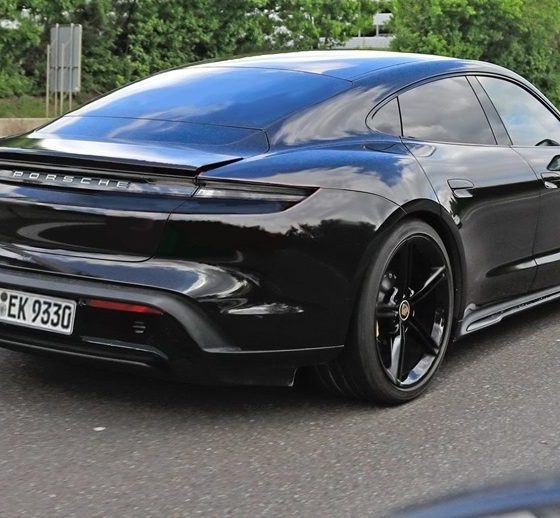

News
Porsche exec credits Tesla for proving EV demand, reveals Taycan reservation details
Porsche Cars North America president and CEO Klaus Zellmer recently shared his insights about what he perceives to be the upcoming widespread adoption of electric cars. In an op-ed published on USA Today, Zellmer argued that the demand for electric vehicles is definite at this point, and it will only be a matter of time before the United States’ roads are filled with EVs.
While the Porsche CEO continues to prepare for the arrival of the Taycan, he nonetheless gave credit to Tesla for making “inroads” in the push for battery-electric vehicles. Zellmer argued that Tesla has all but proven that there is “significant demand” for electric cars, particularly those which combine sustainability with performance and design.
“Last year, the Model 3 outsold any other premium sedan in the US. We know that American consumers embrace new technology, especially if it delivers a new experience. And once a technology catches on, consumers respond well to expanded choice as competitors enter the field. Just look at how many models of SUV you can buy today, or the proliferation of smartphones since Apple introduced the iPhone in 2007,” he wrote.
Apart from the demand for electric vehicles being all but certain, the Porsche CEO added that the expansion of EV charging infrastructure is starting to hit its stride, as shown by the efforts of companies like Electrify America, ChargePoint, and EVgo. Zellmer also argued that electric cars are cleaner than they have ever been, thanks to a grid that is steadily becoming greener.
Nevertheless, perhaps the most notable sign for the Porsche CEO was the demand the German carmaker is seeing for its first modern all-electric vehicle, the Taycan. According to Zellmer, there is enough interest in the Taycan to fully account for Porsche’s production of the vehicle through late 2020.
“We already have enough interest to account for all the Taycans we expect to deliver in the US in the first year, through late 2020. That’s powerful, given that the final production model has yet to be unveiled. And the market potential is so strong that we just announced we will switch our best-selling model, the Macan compact SUV, to all-electric in the next few years,” he wrote.
A particularly interesting tidbit given by Zellner in his op-ed involves some details about the demographic that the Taycan has been attracting. The CEO mentioned that fewer than half of the Taycan’s reservation holders are current Porsche owners, but from those who are, the biggest single group own a Porsche 911, the company’s flagship vehicle.
“The fact that someone can love the sound and feel of an exhilarating flat-six gas engine and also be attracted to the silent power of a performance EV says volumes about the capacity of the US market for this new power train,” Zellmer stated.
Porsche is currently preparing for the launch of the Taycan, which is expected to be held this coming September. The final details of the vehicle are yet to be released by the company, though reports have emerged stating that the car will come in three variants: a base rear-wheel-drive Taycan that’s equipped with an 80 kWh battery pack, a mid-range Taycan 4S that’s fitted with a 96 kWh battery, and a top-of-the-line Taycan Turbo, which will also feature a 96 kWh battery. Recent reports have also hinted at possible upcoming variants for the vehicle, such as the Taycan Turbo S and a lighter, RWD Taycan GTS that will likely be optimized for track driving.
The full text of Porsche Cars North America CEO and president Klaus Zellmer insights on electric car adoption, Tesla, and the Taycan could be accessed here.

Elon Musk
Elon Musk and Tesla AI Director share insights after empty driver seat Robotaxi rides
The executives’ unoccupied tests hint at the rapid progress of Tesla’s unsupervised Robotaxi efforts.

Tesla CEO Elon Musk and AI Director Ashok Elluswamy celebrated Christmas Eve by sharing personal experiences with Robotaxi vehicles that had no safety monitor or occupant in the driver’s seat. Musk described the system’s “perfect driving” around Austin, while Elluswamy posted video from the back seat, calling it “an amazing experience.”
The executives’ unoccupied tests hint at the rapid progress of Tesla’s unsupervised Robotaxi efforts.
Elon and Ashok’s firsthand Robotaxi insights
Prior to Musk and the Tesla AI Director’s posts, sightings of unmanned Teslas navigating public roads were widely shared on social media. One such vehicle was spotted in Austin, Texas, which Elon Musk acknowleged by stating that “Testing is underway with no occupants in the car.”
Based on his Christmas Eve post, Musk seemed to have tested an unmanned Tesla himself. “A Tesla with no safety monitor in the car and me sitting in the passenger seat took me all around Austin on Sunday with perfect driving,” Musk wrote in his post.
Elluswamy responded with a 2-minute video showing himself in the rear of an unmanned Tesla. The video featured the vehicle’s empty front seats, as well as its smooth handling through real-world traffic. He captioned his video with the words, “It’s an amazing experience!”
Towards Unsupervised operations
During an xAI Hackathon earlier this month, Elon Musk mentioned that Tesla owed be removing Safety Monitors from its Robotaxis in Austin in just three weeks. “Unsupervised is pretty much solved at this point. So there will be Tesla Robotaxis operating in Austin with no one in them. Not even anyone in the passenger seat in about three weeks,” he said. Musk echoed similar estimates at the 2025 Annual Shareholder Meeting and the Q3 2025 earnings call.
Considering the insights that were posted Musk and Elluswamy, it does appear that Tesla is working hard towards operating its Robotaxis with no safety monitors. This is quite impressive considering that the service was launched just earlier this year.
Elon Musk
Starlink passes 9 million active customers just weeks after hitting 8 million
The milestone highlights the accelerating growth of Starlink, which has now been adding over 20,000 new users per day.

SpaceX’s Starlink satellite internet service has continued its rapid global expansion, surpassing 9 million active customers just weeks after crossing the 8 million mark.
The milestone highlights the accelerating growth of Starlink, which has now been adding over 20,000 new users per day.
9 million customers
In a post on X, SpaceX stated that Starlink now serves over 9 million active users across 155 countries, territories, and markets. The company reached 8 million customers in early November, meaning it added roughly 1 million subscribers in under seven weeks, or about 21,275 new users on average per day.
“Starlink is connecting more than 9M active customers with high-speed internet across 155 countries, territories, and many other markets,” Starlink wrote in a post on its official X account. SpaceX President Gwynne Shotwell also celebrated the milestone on X. “A huge thank you to all of our customers and congrats to the Starlink team for such an incredible product,” she wrote.
That growth rate reflects both rising demand for broadband in underserved regions and Starlink’s expanding satellite constellation, which now includes more than 9,000 low-Earth-orbit satellites designed to deliver high-speed, low-latency internet worldwide.
Starlink’s momentum
Starlink’s momentum has been building up. SpaceX reported 4.6 million Starlink customers in December 2024, followed by 7 million by August 2025, and 8 million customers in November. Independent data also suggests Starlink usage is rising sharply, with Cloudflare reporting that global web traffic from Starlink users more than doubled in 2025, as noted in an Insider report.
Starlink’s momentum is increasingly tied to SpaceX’s broader financial outlook. Elon Musk has said the satellite network is “by far” the company’s largest revenue driver, and reports suggest SpaceX may be positioning itself for an initial public offering as soon as next year, with valuations estimated as high as $1.5 trillion. Musk has also suggested in the past that Starlink could have its own IPO in the future.
News
NVIDIA Director of Robotics: Tesla FSD v14 is the first AI to pass the “Physical Turing Test”
After testing FSD v14, Fan stated that his experience with FSD felt magical at first, but it soon started to feel like a routine.

NVIDIA Director of Robotics Jim Fan has praised Tesla’s Full Self-Driving (Supervised) v14 as the first AI to pass what he described as a “Physical Turing Test.”
After testing FSD v14, Fan stated that his experience with FSD felt magical at first, but it soon started to feel like a routine. And just like smartphones today, removing it now would “actively hurt.”
Jim Fan’s hands-on FSD v14 impressions
Fan, a leading researcher in embodied AI who is currently solving Physical AI at NVIDIA and spearheading the company’s Project GR00T initiative, noted that he actually was late to the Tesla game. He was, however, one of the first to try out FSD v14.
“I was very late to own a Tesla but among the earliest to try out FSD v14. It’s perhaps the first time I experience an AI that passes the Physical Turing Test: after a long day at work, you press a button, lay back, and couldn’t tell if a neural net or a human drove you home,” Fan wrote in a post on X.
Fan added: “Despite knowing exactly how robot learning works, I still find it magical watching the steering wheel turn by itself. First it feels surreal, next it becomes routine. Then, like the smartphone, taking it away actively hurts. This is how humanity gets rewired and glued to god-like technologies.”
The Physical Turing Test
The original Turing Test was conceived by Alan Turing in 1950, and it was aimed at determining if a machine could exhibit behavior that is equivalent to or indistinguishable from a human. By focusing on text-based conversations, the original Turing Test set a high bar for natural language processing and machine learning.
This test has been passed by today’s large language models. However, the capability to converse in a humanlike manner is a completely different challenge from performing real-world problem-solving or physical interactions. Thus, Fan introduced the Physical Turing Test, which challenges AI systems to demonstrate intelligence through physical actions.
Based on Fan’s comments, Tesla has demonstrated these intelligent physical actions with FSD v14. Elon Musk agreed with the NVIDIA executive, stating in a post on X that with FSD v14, “you can sense the sentience maturing.” Musk also praised Tesla AI, calling it the best “real-world AI” today.








